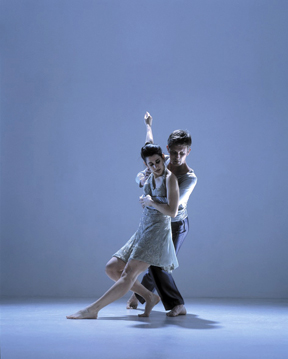Smoothies
Richard Alston Dance Company
The Joyce Theater
New York City
Friday, February 17, 2006
By Nancy Dalva
copyright 2006 by Nancy Dalva
 Richard Alston's tasteful and musical choreography arrived in New York on his sleek, personable, technically adept, eponymous troupe, with three pieces all different, yet all alike. The first, "Fever," was to an especially wonderful recording (by the Concerto Italiano, Rinaldo Alessandrini, director)of Monteverdi madrigals and sinfonias. (Like Paul Taylor, he has solved the "recorded music" problem by using an excellent, interesting, idiosyncratic recording.) The second, with Jason Ridgway, in person, limpidly playing Chopin at an on stage piano, was called "Such Longing." The third was to some fabulous tracks from the CD called "Electric Gypsyland." This last number had a curious British-Brazilian flavor. "Sleeping Beauty" meets "Orfeo Negro," sort of.
Richard Alston's tasteful and musical choreography arrived in New York on his sleek, personable, technically adept, eponymous troupe, with three pieces all different, yet all alike. The first, "Fever," was to an especially wonderful recording (by the Concerto Italiano, Rinaldo Alessandrini, director)of Monteverdi madrigals and sinfonias. (Like Paul Taylor, he has solved the "recorded music" problem by using an excellent, interesting, idiosyncratic recording.) The second, with Jason Ridgway, in person, limpidly playing Chopin at an on stage piano, was called "Such Longing." The third was to some fabulous tracks from the CD called "Electric Gypsyland." This last number had a curious British-Brazilian flavor. "Sleeping Beauty" meets "Orfeo Negro," sort of.
There isn't much dancers of the quality of this troupe cannot do, and do neatly, with pointed foot, clear arch, polish, finish. But they are suppressed, somehow, if not by the work—which occurs at a more or less flat level, without much temperamental variety, and, to a piece, ends rather than concluding–than by the glossy and impeccable production values encasing it. Lovely costumes, and the most lambent, low, candle-in-the-night light—a real Prince of Darkness turn (times three) by Charles Balfour. He doesn't light the space—except for one chill passage of harsh blue down-spots, which made no sense to me at all in terms of the material—so much as the dancers, so that they appear as insects trapped in amber. I would love to see these dances in a studio, in daylight, or in a theater under work light, to see if they have intrinsic qualities of projection that are being masked here, like a sauce veloute napping an entre. The numbers were all more or less for lovers, more or less unfolding like a piano ballet (which the second was), in a series of dance episodes unlinked by progression. Everything seemed transposable, but for the fidelity to the scores. This was partly metrical, and partly moody. The feel of the music, mostly, and also the tempi. Everything could be swooped into, lofted to, or, in the last case, hotted to.
Alston is a musically sensitive and highly tasteful and accomplished choreographer, but I wondered, after this evening, about work so lacking in subtext. It all seemed surface—lovely surface, to be sure, but merely surface. (It would be unfair to call him the British David Parsons—unfair to both, such comparisons being by nature invidious and a kind of elliptical cheating by the comparer—but to say so will conjure for an American audience the notion of open, accessible, cleanly rendered, squeaky clean even when suggestive choreography.) There's nothing wrong with surface, of course. People glide a very long way on it. I will want to see more Alston—who is after all a Commander of the British Empire and whose accomplishments and training are not merely formidable, but admirable—before I think he's just a smoothie, and I'd like to really see it, next time. Lose the glow, and show us what's hidden, next time you visit from your green and pleasant land.
Photo of "Such Longing" by Hugo Glendenning.
Volume 4, No. 8
February 27, 2006
copyright
©2006 Nancy Dalva
www.danceviewtimes.com
|
|